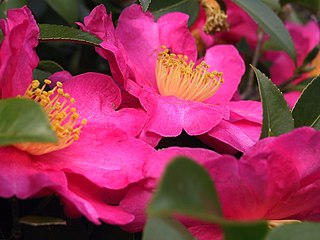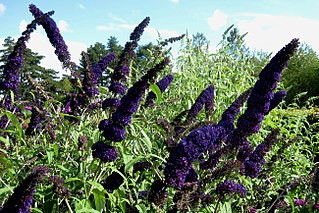
Camellia is a genus of flowering plants in the family Theaceae. They are found in eastern and southern Asia, from the Himalayas east to Japan and Indonesia. There are 100–300 described species, with some controversy over the exact number. There are also around 3,000 hybrids. The genus was named by Linnaeus after the Jesuit botanist Georg Joseph Kamel, who worked in the Philippines and described a species of camellia. Camellias are famous throughout East Asia; they are known as cháhuā in Chinese, tsubaki (椿) in Japanese, dongbaek-kkot (동백꽃) in Korean, and as hoa trà or hoa chè in Vietnamese.

Syringa vulgaris is a species of flowering plant in the olive family Oleaceae, native to the Balkan Peninsula, where it grows on rocky hills. This species is widely cultivated as an ornamental and has been naturalized in other parts of Europe, as well as much of North America. It is not regarded as an aggressive species, found in the wild in widely scattered sites, usually in the vicinity of past or present human habitations.

Canna indica, commonly known as Indian shot, African arrowroot, edible canna, purple arrowroot, Sierra Leone arrowroot, is a plant species in the family Cannaceae. It is native to much of South America, Central America, the West Indies, Mexico, and the southeastern United States. It is also naturalized in much of Europe, sub-Saharan Africa, Southeast Asia, and Oceania. Canna indica has been a minor food crop cultivated by indigenous peoples of the Americas for thousands of years.

Canna Italian Group 'Trinacria Variegata'. The earliest mention of this cultivar is in 1927, An Amateur in an Indian Garden by S. Percy-Lancaster, F.L.S., F.R.H.S., M.R.A.S., in which it was described and referred to by this name.

Canna Italian Group 'Roma' is a tall aquatic Italian Group cultivar, equally at home as a water marginal or in the border; large green foliage, oval shaped, white margin, upright habit; round stems, coloured green & purple; flowers are open, yellow with orange blotches, throat red-orange, staminodes are large, edges lightly frilled, stamen is orange-red, petals red, fully self-cleaning; seed is sterile, pollen is low fertile; rhizomes are long and thin, coloured white and pink; tillering is prolific. Introduced by C. Sprenger, Dammann & Co., Naples, Italy, EU in 1898.
Canna 'Austria' is a medium sized Italian Group Canna cultivar with green foliage, oblong shaped, upright habit; oval stems, coloured green; flowers are cupped, self-coloured yellow, throat orange-red spots on yellow, staminodes are large; seed is sterile, pollen is low fertile; rhizomes are long and thin, coloured white; tillering is prolific. Introduced by C. Sprenger, Dammann & Co., Naples, Italy, EU in 1893.

Canna 'Florence Vaughan' is a medium Crozy Group canna cultivar; green foliage, oval shaped, branching habit; oval stems, coloured green; flowers are open, yellow with red spots, staminodes are medium size, edges regular, fully self-cleaning; fertile both ways, not self-pollinating or true to type, capsules globose; rhizomes are thick, up to 3 cm in diameter, coloured white; tillering is average. Introduced by A. Crozy, Lyon, France in 1892.
Canna 'Yellow King Humbert' Burbank is a medium sized Italian Group Canna cultivar; foliage green, but often variegated purple markings and occasionally whole leaves purple, oval shaped, spreading habit; oval stems, coloured green + purple; flower clusters are open, spotted, colours yellow with red spots, often large red markings and occasionally whole flowers red, staminodes are large; seed is sterile, pollen is sterile; rhizomes are long and thin, coloured white and purple; tillering is prolific.
Canna 'Roi Humbert' is an Italian Group canna cultivar; bronze foliage, ovoid shaped, spreading habit; oval stems, coloured purple; flowers are cupped, self-coloured scarlet, staminodes are large, edges ruffled, fully self-cleaning; seed is sterile, pollen is sterile; rhizomes are thick, up to 3 cm in diameter, coloured purple; tillering is average. Introduced by C. Sprenger, Dammann & Co, Naples, Italy, EU in 1908.

Canna 'R. Wallace' is a medium sized, Crozy Group canna cultivar; green foliage, oblong shaped, white margin, spreading habit; round stems, coloured green; flowers are open, pale yellow with red spots, staminodes are large, edges regular, stamen is rose-red with small yellow flecks; fertile both ways, not self-pollinating or true to type, capsules round; rhizomes are thick, up to 3 cm in diameter, coloured white and pink.
Sydney Percy-Lancaster, F.L.S., F.R.H.S., M.R.A.S. was born on 19 July 1886 at Meerut, India. His father, Percy Lancaster, was a banker and a talented amateur gardener, who went on to become the Secretary of the Agri Horticultural Society of India in Calcutta, India.
Wilhelm Pfitzer was a German horticulturist.

Carl Ludwig Sprenger was a German botanist, born on 30 November 1846 at Güstrow, Mecklenburg and died 13 December 1917 on the island of Corfu (Kérkyra).

Pierre Antoine Marie Crozy (1831-1903) [also called Crozy aîné—French for "elder"] was a nineteenth-century French rose breeder. He was a partner in the French firm, Avoux & Crozy, La Guillotière, Lyon, actively breeding roses from the 1850s to 1860s. From the early 1860s until his death in 1903 he was also hybridising Canna species, and introduced many hundreds of new cultivars. The largest Canna Group today is still called the Crozy Group, and many of those cultivars are still being raised.
Canna 'Trinacria' is a tall 'Italian Group' Canna cultivar; with light green foliage, large, oval shaped, branching habit; clusters of flowers are open, sulphur-yellow with faint red spots in the throat, staminodes are large, throat pearl base; labellum is sulphur-yellow, throat pearl; stamen is sulphur-yellow, style is sulphur-yellow, petals green, fully self-cleaning, good bloomer; seed is sterile, pollen is low fertile; rhizomes are long and thin, coloured white; tillering is prolific. Introduced by C. Sprenger, Dammann & Co., Naples, Italy, EU.
Théodore Année was a French horticulturist. He was a wealthy diplomatic consul in South America when he retired to France in the mid-1840s and settled in rue des Réservoirs, Passy, Paris, where he devoted himself to the culture of tropical plants from South America, having brought back with him the taste for plants with beautiful foliage, especially the Canna genus.

Buddleja davidii 'Black Knight' has been one of the most successful davidii cultivars ever released. A selection made by Ruys at the Moerheim Nursery, Dedemsvaart, Netherlands, circa 1959, it was accorded the RHS Award of Garden Merit in 1993. Seed is very viable, germination per 0.1 gram averaging 100, or approximately 600 fertile seeds per panicle.













